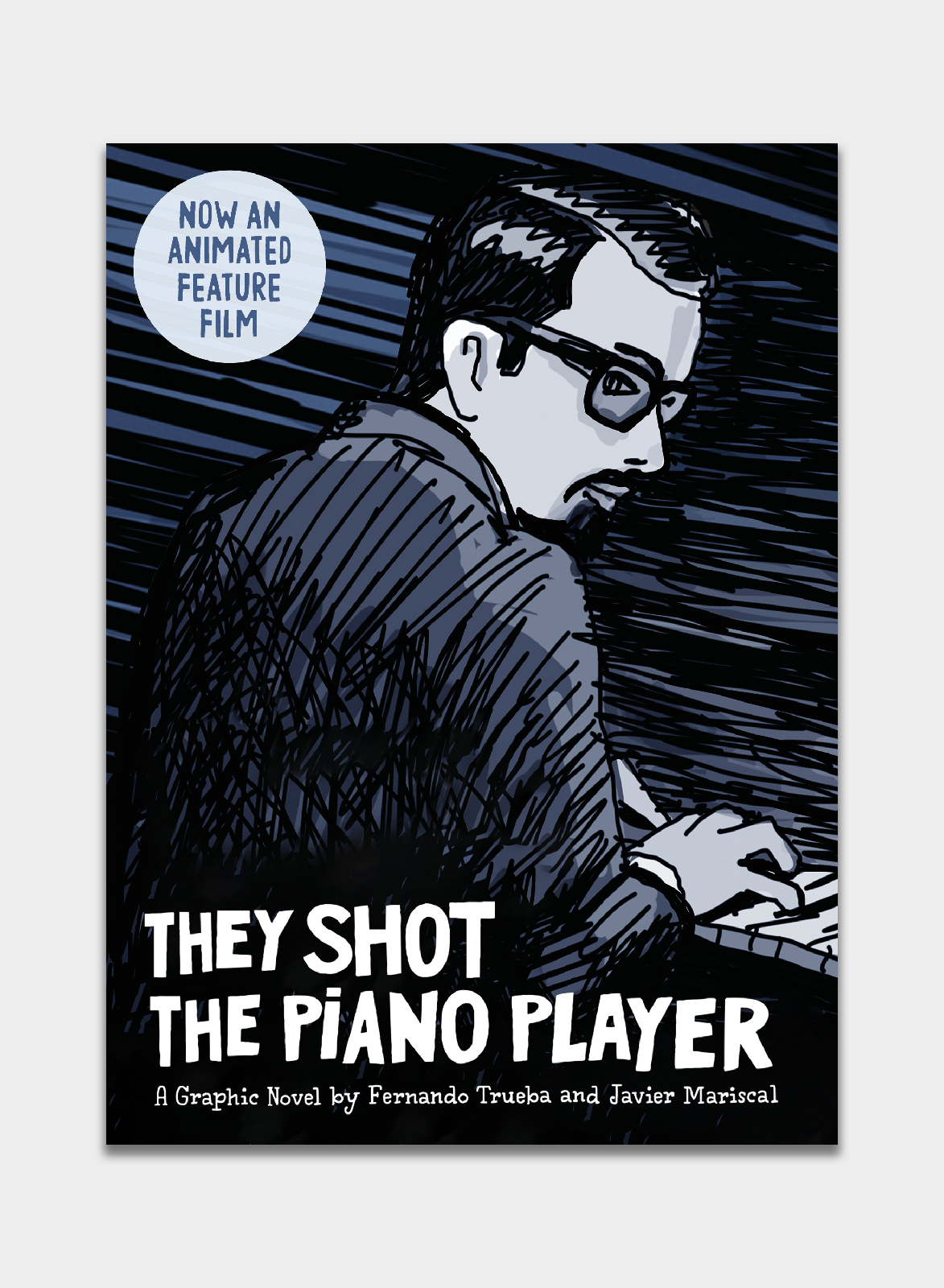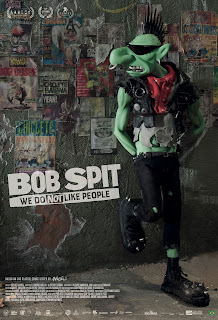 Bob Spit – We Do Not Like People, Cesar
Cabral. Coala Filmes, 2021.
Bob Spit – We Do Not Like People, Cesar
Cabral. Coala Filmes, 2021.
Reviewed by Pedro Moura
Bob Spit is an hour-and-half
stop-motion animation/feature documentary film directed by Cesar Cabral about
Brazilian cartoonist extraordinaire Angeli. The film was awarded Best Feature
at the Contrechamp section in the international animation festival of Annecy in
2021, a section which is “dedicated to,” in the words of Variety's Jamie
Lang, “emerging talent from around the world and
films that lie outside the mainstream.”
As the title reveals, the focus of attention is
Bob Spit (originally “Bob Cuspe”), one of Angeli's most known characters from
the 1980s. But it also threads the needle through the artist's oeuvre, his
creative block, his aging, and a fair degree of nostalgia. This is a
non-fiction project mixed with fiction, in which we'll slide through various
degrees of remove from a purportedly “real” - stop-motion animation,
documentary angles, the diegetic world of the character, historical
contextualizations, fantasy, and so on.
Without wanting to rehash the discussion about
the feasibility and pertinence of talking about “animated documentaries,”
something that has been discussed by people far more informed than me, I
believe that Bob Spit will nevertheless become a very good example of
such an expanding field. Foremost, for being an exploration of interpretative
frameworks larger and more profound that a supposedly “objective” or
“journalistic” approach. We literally delve into Angeli's psyche, but in
an oblique manner, so instead of having clear-cut decisive conclusions, we are
rather invited to keep on thinking about the issues for ourselves.
The film follows two major storylines. On the
one hand, we have an interview set in Angeli's apartment, where he clearly
answers an interlocutor sitting off camera, discussing his work, career and
life, showing archival material, and sometimes accessing third parties that
talk about him. Angeli finds himself in a bind, and refuses to be stuck to
older glories. So he resorts to recycling a strategy and decides to kill off
Bob Spit, as he did before with other characters.
On the other hand, we follow what seems to be a
fictive roadtrip adventure. The titular character, Bob Spit, embarks on a
journey, crossing a desert-like, post-apocalyptic landscape, in his quest to
meet his creator, Angeli. After learning of the cartoonist's plan to kill him –
through the “prophecies” of tattered pages of the comics he stars in – Bob vows
to take vengeance on his own creator.
We must always bear in mind that when we’re
speaking of this whole interview setting, we are referring to a construction.
After all, everything is depicted through three-dimensional puppets and
backgrounds. The artificiality of the interview is made “natural” by making
visible the presence of the filming crew, not only through dialogue but also
through metatextual techniques such as video framing, timestamps, and other
materiality traces. But if animated documentaries allow us to go well beyond
indexicality, some of the less conventional techniques followed by Cabral bring
about other issues, that keep us off balance and therefore alert at all times.
For instance, there are momentary “glitches”
that allow us to see the actual photographic footage of the interviews Cabral
and his crew did with Angeli, which can be seen as the supposed scaffolding of
the final animated plane. So the film never leaves us in a continuously
comfortable state of watching what unfolds. We are permanently jarred back and
forth in these dimensions. According to Annabelle Honess Roe, “the use of
animation as a representational strategy broadens the potential of documentary
by expanding the range of what can be shown and told” (Animated Documentary).
And what is shown and told in Bob Spit goes well beyond the Brazilian
cartoonist's take on his own work.
Somewhat like the Quay Brother's Street of
Crocodiles, it's as if we have access here to multiple levels of reality
and existence – Angeli's “normal life” and Bob Spit's imaginary adventure
storyworld –, but we do not have a precise map of how one level relates
ontologically to the other. It would be easy to say that the latter is an
extension of Angeli's “imagination” or “stories,” but it gets more complicated
than that, in a crooked Lynchian logic sort of way. Nevertheless, there is a
certain coherence and fluidity to this patchwork, as the director dovetails the
artist's life, thoughts and art into a continuous unfolding thread. Mostly,
this stems from the overall framing of Angeli's voice taking precedence over the
whole narrative. At one point, someone asks Angeli if they can ask him a
question. Angeli simply answers, “No.” Not because there are no questions to be
asked or no answers to be given, but because we are always already within the
discourse that makes up the whole text.

Notwithstanding, the projects allows for a
number of shifting points of view. Apart from Angeli's speech, we go into the
fictive underworld of Bob Spit, even if his adventure is mostly framed by the
Kowalski twins. But, as mentioned above, we also have access to Angeli's wife
Carol, fellow cartoonist Laerte (yet another giant from the 1980s, still
extremely active today and admired by Angeli) and the ex-editor/taxi driver,
which has a few words of choice about the author. Later on, other characters
appear, bringing other types of “glitches” into the mix.
Arnaldo Angeli Filho was born in São Paulo in
1956, and belongs to a generation of self-taught artists who were heavily
influenced by the preceding golden age of Brazilian illustrators, comics
artists and cartoonists, upholding thus a genuine national tradition, even if
mixing it with the most diverse sources of foreign material. In Angeli's case,
the influence of Robert Crumb is unmistakable, specifically his ability to come
up incessantly fully formed characters, many of which would become recurrent.
From the hippie duo Wood & Stock to the sexual deviant Rê Bordosa and, of
course, the anti-social yet shrewd commentator Bob Cuspe.
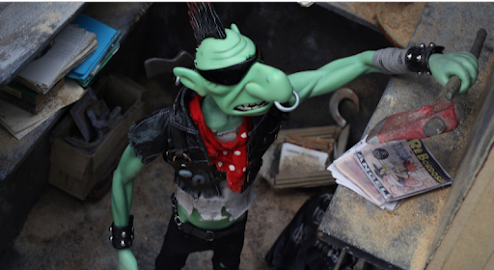
Most, if not all of these characters were born
in the daily strips he created in the early 1980s in the pages of the Folha
de S. Paulo, in which he had been working as a very politicized and
combative editorial cartoonist since 1973. Around that same era, his interest
for comics proper lead him to several editorial projects, thanks to a
collection put out by the publishing house Circo, called Chiclete com Banana
(“Gum with Banana;” really, I'm not kidding, it's not “of”). Its success was so
great that the publishers decided to give Angeli a regular magazine. This also
heralded an outstanding number of influential titles presenting a powerhouse
new generation of cartoonists, including Laerte and Glauco, with whom Angeli
would form an informal trio for years to come.
Chiclete com Banana would
feature then a plethora of characters, including the “pervert” variant of the
two-kid team trope Skrotinhos to con man/spiritual leader Rhalah Rikhota, both
of whom appear in this very same film. But many, many others would be penned by
Angeli, all of them hilarious stock characters very much related to the
cultural specificities of the city of São Paulo (arguably the cultural capital
of Brazil, or at least so “Paulistanos” like to believe).
This is not the first time Angeli is involved
with filmmaking. In 2006 Otto Guerra adapted another character-driven strip into
Wood & Stock: Sex, Oregano and Rock'n Roll. Cesar Cabral
directed first a short based on Rê Bordosa in 2008, and in 2017 launched a
television series called Angeli the Killer, in which he adapted many of
the cartoonist's stories, brought his characters to life and conducted (and
animated in stop-motion) interviews. To a certain extent, Bob Spit, the
movie, is an extension of that project. But it is also a simplification, as it
attempts to create a more or less linear and organized structuring of its themes,
instead of the more loose, hectic and even frantic pace of the tv series.
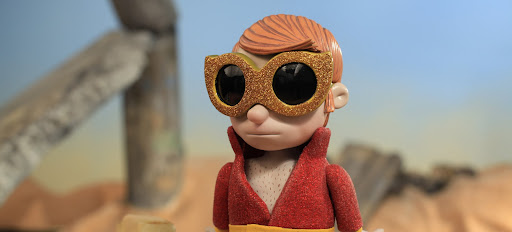
Bob Spit brings a visual dynamic that
was not extant in the original material: color, three-dimensionality and a
certain lightness to it all. We should bear in mind that Angeli's original work
was made out of heavy, “scratchy”, “dirty” hatchwork, very typical of a certain
underground aesthetics. Coloring, and subdued, murky one at that, would come
later. But Cabral's own capability for character design and construction, their
dynamic movements, the framing and camera work makes up for a technically solid
piece of work. Cabral’s use of an incredible variety of sounds sources,
including “classic” Brazilian punk rock anthems of the 80s, creates nonetheless
a seamless surface that eases the many transitions between planes and subjects.
To watch a stop-motion character drawing on paper is an amazing experience,
even if for the briefest of moments.
To be precise, while the main two storylines are
depicted through stop animation techniques, there are other interpolated
techniques, used as brief transition bumpers (but which sometimes are also used
to convey further contextual information). In some of these, the animations
made out of the strip's art – basically quickly superimposing several of the
strips' panels, but judiciously choosing similar positions of the character— is
superb. And these scenes are particularly good precisely because they do not
aim to disguise their origins or bring up the idea that “animated cartoons” are
better than the original drawn cartoons, but because they leave visually
present the variegated materiality of the original newsprint, including within
their transition effects.
While Angeli's more recent work is slightly more
introspective, sometimes with the cartoonist drawing himself, and engaging,
quite often with zen-like adages, his 1980s and 1990s work, from which this
movie stems, was quite virulent, frank and adversarial. In a word, punk. But
what is at stake in Bob Spit is not simply an adaptation of those
stories. Angeli appears in his present age, preferring to stay home, listening
to records, working alone and uninterrupted. And Bob Spit himself is not his
old self, living in the busy streets of São Paulo. He looks slightly tired,
living off the flesh of maimed mutant Elton Johns, unable to spit (his
trademark move, and hence his name). The possibility of killing his creator is
the only little spark of joy that seems achievable, and even that does not
change his demeanor. To put it simply, neither creator nor created character
are the personalities that they once were, and that most people remember. There
may be a hint of nostalgia in making this documentary, but both Angeli and Bob
Spit himself suffer no fools gladly and are willing to disabuse people of their
expectations.
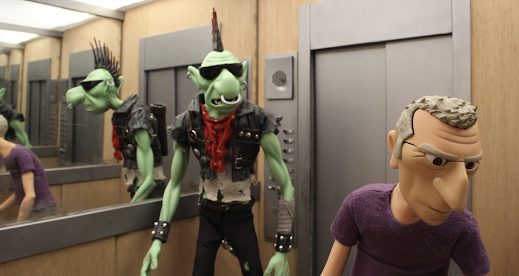
Another potentiality of the animated documentary
underlined by Roe is its capacity to what she calls “pointing inwards,” i.e.,
the possibility of employing non-mimetic strategies that go beyond issues of verisimilitude
and evocative planes that open up to more complex, less directly accessible
emotional or inner mental states of the portraitee. In this case, many of the
silences, hesitations and half-explored emotions by Angeli gain a body of their
own in the imagetic translations. While
the film is not dealing with repressed memories or clear-cut traumas, as is the
case of the world-famous case of Ari Folman's 2008 Waltz With Bashir, Bob
Spit sometimes hints at the idea that the “road trip level” of Angeli's
characters may correspond to a “sub-level” of Angeli's psyche. Angeli speaks
(in the film, but also famously elsewhere) of his problems with alcohol, drugs
and sexual behavior. After all, the Kowalskis, the Elton Johns and Bob Spit
inhabit sewers, underground bunkers and tunnels beneath derelict urban
landscapes (even though it’s filled with Easter Eggs, such as the curvy hill of
Mara Tara’s thighs). They cross dilapidated and abandoned streets and roads,
and when finally Bob emerges into Angeli's world, he seems to comes from below
a sofa in which Angeli was sleeping. Were we watching that which Angeli was
dreaming? They seem to touch each other briefly, but Angeli awakes. But soon
enough, while on the elevator, a scene plays out a wonderfully staged crossing
of worlds, as Angeli and Bob Spit finally meet each other. Characters rebelling
against their creators is not necessarily new (Fleischer's Out of the
Inkwell dates back to 1918), and neither is the clash of the different
ontological worlds of creator and created (e.g. Grant Morrison's Animal Man,
or even the 2006 Marc Forster's Stranger than Fiction), but there is
something strangely satisfactory in watching an old familiar character
conquering a different degree of autonomy in relation to both his author and
audience, confirming his contrarian, punkish ethos.

For the people who are knowledgeable
about Angeli's work and these characters, the film offers an opportunity to
re-engage with, and re-interpret it all with hindsight. Is Bob's punkish verve,
the smash-it-all, kicking-against-the-pricks, spit-on attitude still an answer
to society's problems? To apathy? To the sure destruction of the world? To the
idiocy that surrounds us? Now that we are older, that our backs hurt, and that
we don't want to get around much anymore, we may think we don't have the same
energy, sure. But deep inside, just as Angeli in the end leans over his window,
above the anonymous streets below, and spits, we think to ourselves, as
Bob Spit would have said, “Fuck,
yeah!
A version of this review will appear in print in IJOCA 23:2.
~~~~~~~~
Since this material will be unfamiliar to many of our readers, the following is from the movie's press release and a preview is on YouTube :
BOB
SPIT - WE DO NOT LIKE PEOPLE is a stop-motion animation that mixes
documentary, comedy and road-movie. It tells the story of Bob Spit, an
old punk trying to escape from a post-apocalyptic desert that is
actually, a purgatory inside the mind of his creator, Angeli, a
cartoonist going through a creative crisis.The story is freely inspired
by the life and work of one of the most celebrated Brazilian cartoonists
of all times, Angeli, who became famous in the 70s by releasing
political cartoons in the midst of Brazil’s military dictatorship. In
the 80s, he migrated to daily strips, showing an acid sense of humor to
represent Brazil’s society, day-to-day life and customs. Angeli had
editorial success with his monthly magazine “Chiclete com Banana,” which
sold over 120 thousand copies per edition. During his time, the
cartoonist has created some of his most famous characters: the bohemian
diva Rê Bordosa, the hippie pair Wood & Stock, and the punk Bob
Spit.
DIRECTOR’S BIOGRAPHY
Cesar Cabral has a degree
in Cinema through the Arts and Communication School - São Paulo
University (ECA-USP). He began his career as a stop-motion animator in
1998 and co-founded the animation company Coala Filmes in 2000. He
directed the stop-motion short films The Re Bordosa Dossier (2008),
which won more than 70 awards in Brazilian and international film
festivals, and Storm (2010) selected to many prestigious film festivals
all around the world, such as Annecy, Hiroshima, Havana and Sundance.
Cesar created and directed 2 seasons of the young adult stopmotion
animated series Angeli The Killer, selected to 2018 Annecy Film Festival
and broadcasted at Canal Brasil. Bob Spit - We Do Not Like People was
awarded best feature at Contrechamp section in Annecy 2021.
With the voices of Milhem Cortaz, Paulo Miklos, Grace Gianoukas, André Abujamra, Laerte, Hugo Passolo, Angeli.
MILHEM CORTAZ does Bob Spit’s original voice. One of Brazil’s most
exciting actors, he has played parts in films such as “Elite Squad”,
“Elite Squad 2”, “Carandiru” and the DGA nominated "A Wolf at the Door." He has also voiced the character in the series “Angeli The Killer”
PAULO MIKLOS does the characters’ original voice for THE KOWALSKI
BROTHERS, who live in the desert gathering pages of the “Chiclete com
Banana” Magazine. When they meet Bob Spit, they encourage him to find
Angeli. A gifted actor and musician, he played in seminal Brazilian
rock band “Titãs” and had striking parts in films and TV Series such as
“O Invasor”, “Estômago” and “É Proibido Fumar”, “Sessão de Terapia” e
“Os Normais.”
ANDRÉ ABUJAMRA does the characters’ original voice of RHALAH RHIKOTA, a
charlatan guru who had his fame and followers in the 80s. He is the
mentor of the Kowalski brothers. A musician, comedian and actor,
Abujamra has a long story in Brazil’s pop rock scene. He was the
composer of “Carandiru”, and has parts in films and tv shows such as
“Estômago” and “A Grande Família”.
GRACE GIANOUKAS is Rê Bordosa’s original voice. RÊ is a junkie diva
who was the most famous of Angeli’s characters. The cartoonist killed
her in the 80s, and since then she is a lingering presence in his life.
An actress, director, screenwriter and producer, she had several roles
in theatre, TV and cinema. She is currently starring in the TV Globo
soap opera “Orgulho e Paixão”.
